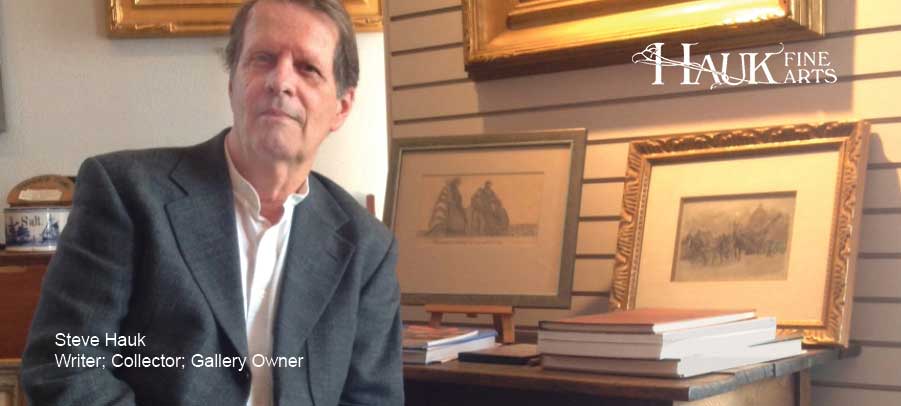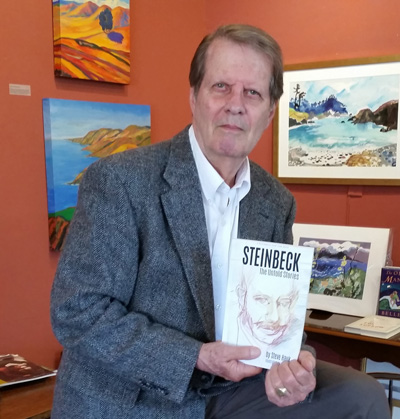Book Signing & Presentation
Pacific Grove writer Steve Hauk will discuss his new book “Steinbeck: The Untold Stories” Friday, Sept 1 at 5:30 p.m. at the National Steinbeck Center, 1 Main Street, Salinas. The event is part of the city’s First Friday Art Walk
The book, a fictional account of several unknown or little known dramatic events in John Steinbeck’s life, is the first print publication of the website SteinbeckNow.com. It includes illustrations by Monterey artist C. Kline especially commissioned for the book.
The stories range from the author’s childhood in Salinas to his final years in New York. They include Steinbeck hiding in the back seat of a car so he can visit his ill mother; encountering a dangerous situation in a Salinas park in a casual reunion of high school classmates; applying for a New York gun license for reasons of self protection, and spending time in Athens during Greece’s political upheaval in the 1960s.
The stories also include tales and character studies of the people who were close to him, usually artists, actors and friends from his childhood and young adult years.
There will be a book signing after the presentation.
___________________________________________________
"Pacific Grove playwright and gallery owner pens fictional account of Steinbeck"POSTED: 06/06/17,Link
Pacific Grove >> While many academic writings about John Steinbeck have documented the author’s life, a new book by playwright and Pacific Grove resident Steve Hauk uses fictional elements to tell stories centered around one of history’s most notable writers.
That’s how Hauk, owner of Pacific Grove’s Hauk Fine Arts and the author of “Steinbeck: The Untold Stories,” describes the work of writings, which is set to be published by the website SteinbeckNow.comon July 22. The book is the product of a two-year collaboration between Hauk and Monterey artist Caroline Kline. Earlier versions of four of the 16 short stories have already appeared on the site.
“It might be in the same way like when Steinbeck wrote ‘Cannery Row’ – he knew the people and the way they actually were and he turned it into fiction,” said Hauk. His book uses Steinbeck’s writings and incorporates the colorful mix of characters he knew and loved in Monterey County and New York to blend both fact and fiction.
Link to full Herald Article
___________________________________________________
Beckett and Cezanne
________________________________________________
Blog Post by Steve Hauk - Apr.08.2009 - 10:29 am
________________________________________________
Samuel Beckett was fascinated by Cezanne.
He was obsessed by art and visited galleries constantly.
Makes sense in a way.
Most of his plays suggest landscapes.
Barren landscapes.
A scraggily tree, interesting to the characters because they might hang themselves from it.
Mounds of dirt and sand from which Nagg or Hamm or Clov might poke out his or her head.
Great dark vistas from which Godot might appear, cresting the horizon ominously, like a bad dream; like, say, a Goya.
I'm not surprised. Beckett's always been spare in his work.
Most art, modern art, at least, by which I mean notable art of the last century or so, is fairly spare, with obvious exceptions, but why go into those, even though I'd trade my soul for an anything but spare John Constable.
Most good painters try to get it down to essentials. Abstract it a bit. Leave something to the imagination of the viewer.
Cezanne, certainly, though I think of him as a kind of constructionist or builder who works from the inside to out.
You see the mountain, Mont St. Victoire, somehow its bones and ribs, but it remains beautiful, like some of Beckett's plays, even though, as one critic rightly said of ``Waiting for Godot,'' ``Nothing happens in the first act, and then in the second act, nothing happens again.''
Beckett had a way of making inaction active.
So did Cezanne.
I like that Beckett liked art because, while I am a writer, I am also an art dealer.
And we have an artist, Belle Yang, who is a wonderful creative writer. Another of our artists, Warren Chang, writes about his art in an academic and instructional sense.
I like the crossing over. One art informs the other, it enriches.
I've always wondered if dealing with art influences my writing.
I was thinking about that last night, after watching the old classic film ``Brief Encounter,'' an adaptation of Noel Coward's play ``Still Life.''
The original title indicates Coward was thinking art when he wrote the play, and when you read the play or see the film, the two lovers stand out as centerpieces in a composition, say a melon and pumpkin (the lovers) backed by a supporting cast of raspberries and grapes.
The thought of a particular still ife might have been all Coward needed to write his play.
Maybe a Cezanne canvas or a Goya depicting cruelty suggested ``Endgame'' or ``Happy Days'' to Beckett.
I didn't know this about Beckett and art until reading a New York Times review by Joseph O'Neill (author of ``Netherland'') of the recently released first volume of Beckett letters published by Cambridge University Press.
But I should have.
Years ago, at Washington University in St. Louis, a nice person allowed Nancy and me to browse the university's amazing Department of Special Collections Manuscript Division.
As I recall, I was able to study James Dickey's original manuscript of ``Deliverance.''
And then, there was the incredible Beckett collection.
We came across one manuscript in his hand that sticks in my mind.
Beckett was writing dialogue, so you'd see three or four or twenty lines of it.
Then the words would stop and for a page or two he would doodle, line drawings of figures, squiggles.
Then he would resume the dialogue.
The very strong impression was that he wanted to keep his pen moving, and when the words didn't come he made do with the drawings.
Until the words came again.
Cezanne, I think, was giving him a hand.
__________________________________________________
__________________________________________________

The Monterey Peninsula and Central Coast have long encouraged artist collaborations.
A few examples –
– John Steinbeck knew and considered friends such artists as Judith Deim, Armin Hansen and James Fitzgerald.
– Carmel poet Robinson Jeffers knew and collected the work of painters Stanley Wood and Kate Carew, and befriended author Langston Hughes.
– Many of the painters and poets knew the famous author and frequent visitor Jack London.
– The great marine biologist Ed Ricketts included Steinbeck, artists Bruce Ariss and Ellwood Graham, writer Jean Ariss and photographer Edward Weston among his friends.
– E. Charlton Fortune began her liturgical art at St. Angela’s Catholic Church in Pacific Grove.
– Pulitzer Prize author William Saroyan not only knew some Peninsula artists, he himself became a painter.
Some little known local ``art’’ facts –
– Dwight Eisenhower painted here when he was a house guest following his presidency.
– Pebble Beach founder Samuel F.B. Morse was, like the former president, an amateur watercolorist.
– The Smithsonian recently published a comprehensive catalogue on Pacific Grove artist Charles Bradford Hudson.
– Diego Rivera visited painter Gottardo Piazzoni at his Carmel Valley dairy goat farm.
– Dickman Avenue in Monterey is named for artist Charles Dickman.
– Robert Louis Stevenson nearly started a major fire in Pacific Grove when his curiosity led him to light some moss hanging from an oak tree.







